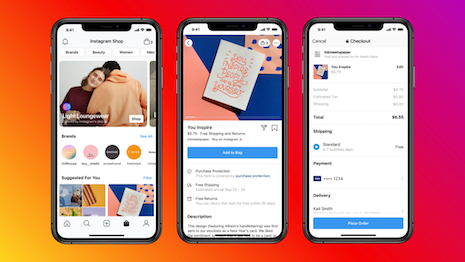A brand’s social media presence is more important than ever, providing myriad opportunities to earn more consumer dollars.
According to the “The State of Social” 2022 report from ListenFirst Media, brands must be cognizant of how the COVID-19 pandemic altered consumer preferences and expectations while being mindful of prominent issues like data privacy and value transparency. Investment in social does not show any signs of ceasing, as 55 percent of brands increased spending on social during the pandemic and half plan to increase their spending in 2022.
“Social media has become the most effective way to get your brand in front of large audiences today,” said Samantha Morse, director of strategy at ListenFirst, in a statement.
The report is based on ListenFirst’s 2021 end-of-year survey among marketing and analyst professionals, performance analysis of social media campaigns across all major channels, discussions with social media marketing leaders from a variety of industries and expert insights from the ListenFirst strategy team.
New expectations
Today, brands are expected to have fresh, innovative content on their social media channels, but to also highlight disparate cultures and points of view while keeping issues like data privacy in mind.
Brands and retailers need to keep an eye on what works in order to succeed on social media, and tracking the right metrics is paramount.
 Forty percent of marketing professionals chose Instagram as the most important social media platform for their brand. Image credit: Instagram
Forty percent of marketing professionals chose Instagram as the most important social media platform for their brand. Image credit: Instagram
Different social platforms offer different experiences for users and marketers. When asked which social media platform was most important to their brand, 40 percent of marketing experts chose Instagram.
Tying social media performance to ROI (return-on-investment) is challenging due to inconsistent results, and only 14 percent of marketers can tie social media efforts to ROI. However, as brands’ teams work arduously to grow their social media presence, it makes sense that more leaders within the brand are requesting reports on the returns.
In 2022, brands’ leadership teams will place even more emphasis on measuring how their social media presence is impacting strategic marketing goals and business objectives.
The power of user-generated content (UGC) is also not to be ignored. In 2021, several brands saw increased demand for their products after TikTok users discussed or featured said products in their videos.
With UGC, brands can achieve an effective balance between promoting their products and connecting genuinely with users taking in their content.
Engagement is still an immensely important metric for brands, as 47 percent of professionals said engagement is the social media metric most important to their work. Marketers must expand their simple methods of engagement, however, to get fuller ideas on how campaigns were received.
 It can be difficult for brands to measure the effectiveness of influencer campaigns. Image credit: Hublot
It can be difficult for brands to measure the effectiveness of influencer campaigns. Image credit: Hublot
Brands must continue implementing effective KPIs (key performance indicators) to receive a full picture of what is working and what is not. Other aspects consumers are craving are a showcase of brand personality and values, brands’ philanthropic efforts and inclusion.
"While some viewers will like your post or even comment on it, that’s a small fraction of your audience,” Ms. Morse said. “There’s a silent majority that can easily go unnoticed if you are not looking at the right metrics.”
Influencer infiltration
Eighty-two percent of brands reported that they will work with influencers in 2022.
As many brands acknowledge the weight behind influencer content and endorsement, 52 percent are still seeking more analytics related to determining how effective influencer content is.
According to the “Measuring the Brand Impact of Influencers” report from ListenFirst, brands should prioritize engagement over followers when evaluating potential influencer partnerships. Identifying patterns in an influencer’s content also helps marketers ensure a good fit when choosing brand partners (see story).
Partnerships with influencers are best received when the content seems genuine and ambassadors seem authentically passionate about the products.
According to a whitepaper from Open Influence, marketers need to balance demographics with psychographics for the most effective campaigns. The best influencer relationships, however, give brands an opportunity to humanize themselves (see story).
{"ct":"+qZkLPhOxy+37gzbCVEF9JOJQerFHxMMtELheBCNPHO\/o9avsnIPJ8wii5blBpPGEYeKQVSo8LnemB0IC60anx\/VAMXbWnBEbiyKQLy3DHJiIAb0rpaoIUsxdTv1wgl9eUVtDrWdGDlBD7EpMzcty39NQ61h2OIscpDtBGEwXY865typu62xGrpBpgBrBlKqfKvQzwljc99KlKNDOOeJsRstUc9s8uUhp0u41k4OGuh7RVat4CukljXIwSywURKrmG\/vaS7OjS\/CjNNQ\/hNaajyYt52dbidp8IsUdkHjlbjIdYsO8M\/8qmDItykYcHOouk0jhaxNHBRIM94Wq6tvKx68ztL0VHaEulGEBVHLDKMgW1Dv8Kvr0MVVkYg3qr6lMqCO80tZB4N+ZFxMboudoybByT1KH89hYL5zZUDI8aOeMB+koVFUVwVeBWGxw40jYUo0AAFRb6pfk4\/7cYu+0bu+1lytl3cxi3FrsMY4lJ1TLOnNDBBBVxtY9CgyPMqpwF+N19F1vhMHuX6O+JV5N4zC8xpqv5ZVwt74jqY9BnA7GaN5frba89cWlkGkv5mVEgbHz6hAVrmBpelSMZby6WOyzbtdjuP70eZZ+Hgf\/hhYE4TsmJhroVNYBQ7PyO3UMJwXcscdrVQlq\/qx\/gw7oCl5Y8hz7xxU4m4L4Lqn+5OdTeumMTPHU33S1\/GVCv4ubXHXy72srv11DRToM3BXg23SXpp5n5dUSCVo2PhIKr2HiqHIDLOdFz+ScUnfeMLq3wCmd3qrvv6Fv6ISmnLhK6XV\/mMgLOMS9fGxep\/9k7aVrhuGe09NnaNCwybAXAMZZxWayBQ9lBeNiXCdJMawW+dd7JDrSQ70AAfP82rwsYIRko6tsRd6LiygR3TTzw7FWBYVQOljNNlQk5Rm8WTKHSXHcUkFvsy8hlPa4HwEcTC7pNgUzAsslbApzV+oqP9vVn0cHenecYI9iVEISWtUAAmbtHV+GCeQB8jf2llZ7Rmet7XDE0ZVwHd403Q15hGc0Zj9Hovz1fjjC5WARg8Y5SA0c7emnX4Mis625Z0haLVQKttLeYCWOZ0s8C1bFAE8hp5jWjQdYmU6U+nEUgcvTc\/YAtcSKBPoCYYzYeZ4yJ5ZTf\/Lm3Yy18DMKAmIMJJCDKLpJK6zBfCrVTYN94WIB5SGo8VREyox4NW\/7FSGg6JLxmH\/BPoZAcByUfc+Ql0VtUYKLi\/XwLLusjVKg1Q88h7x40VHylvUF97fd4XGY3aKtaYH1uNZU+QsByeNVG4qjpt01DM\/1n+FNu7bv\/++KNtF\/pXDp5FWDkkuFOrJj+A9TUN9sN2EUMG7FH0G09QBKtGg4ClaeI5lSB17hyiecm2Ti\/Qwi0pW0aG3mzKFwvPuwic4QuLzG8fCrG96wqPjs4LXyUZrjMwyMoX6R\/liNJXl969Y61PN2jp4fTwF1PeZFWah\/5jdHyoAhT88ufI2pLU\/ZvyLtiNyd2LreXZ8z4OaXFTI\/4cVJU4Wcn4d4L8NTtSTzQu86meC39GMLles+E2guPhAbzLfxdd7niudGCyQyCQjQCbXCN0GPmJjYpGexKXLH\/XSgV\/eEysbfw7+0csKeHhfRVWX4obBRSnua0ZCIMgCGztcnJfO6XXi6\/HhRZFnWDLvV5QxH41BEOFU9UQcgXzTXkySAzobOLlywBZX1u0IYHnY2pzf3ht0b5X5PbWTHneVz7m+seAfQ8o0O92dQmv\/e6V89Gf9GLy4HxBTS42NxUTgi\/ABiJl0MH8Z0YWK\/26caXwwccODNYc5UIBdc6JIINE42i7aUZx2+hHcySFDvXkmCbQtHB1IgdHxYRlkl9PQFO15YCOnARBof1y\/cgqaVnnvaSvcFqD0RCdtSCul7NBfc8jbnAl25Vs8UOVY0KqS3wg0bSv1RnSOOQDTy+Q+zFqkyHGH9A6\/890s3jfE+UmRbOtemmnMsozW75M0jCvsq1c2Llqfwe0UKsLidKp8cVtEmihbwJaz13xjNA+585Z1o+a88f1rtAx5P6jEhvnY80haCXechd+8vjfrhMcmHzX1w+y2TJwpDv+wv+GskbbfDZ3NJLKlFOjIy\/fqDdqwMsp9+niiHplOHHG9txYGiRWZpgTMo2K8Lf7qNPgIgh8oM6vLYg6DbQOQ0HrFwk01PnO9IT6ise4uo7qL7K9UI5e6S2WmoIg6vV+vuh6q0fXDbJlM5kclanCFfqoWdEvfGDgxaUnZ8rnt5wlL7ICMHy786rNyRPEQ69k\/G5s+hzMuQGaC4VheyOuwbcdrN3HAA9H8oMiHcnLdenS8+pSOigr8tCGv4JGQYOkKYPHXT6Jq6pr4xEGu8CKQb9Fq4l9\/0fIO6Ukkkj6UiX4VcPFIUM8\/Wre\/\/XA0zZNxgAiq5mLq8QjRMiNEWXlEVf0RRBmdIwvsicMLrbNCCs5sHGwHFIRQfQXT7z22G8Xey2H9ey8Npd0sWk25rR\/\/4C3GKiPcCABHaYPBd82D09DViRlOWB\/vcn0R4Mtfg38Q6\/nXQuF8wwAMU7oBuNfgXnhju1HNGtXApmsW5qvFB40u\/VpABGT99ni4oAgQ2UtJVPmguIa8UYCHelNcLu4yaupLlRQprkdqr0cnkZMVG9+DDO6XV24InL78t+da0XvWjEM9lvTjuX7RH\/YNW\/ZBux9wmZjyLDMnQo50AC6KetWYYO\/Ldi6NH21ebfQu6OVsK+5kP4HrU7ZX3hOwRwJ9a9zs0d0H+fDYMsBYYAAQpDVPLn1tz7WdGFSnCzGE3qqI1dDhDeZz5v8+jG5rdkYKJtitFoc8Qi+Aj4PAqlk+ikX0bJhmPC+7jdDn1rgpz7Yig1MwoeRG02dU6mC2l93qz5IEmCCpVOz\/J\/d9w+aLH3FOcHsgLMUgrUbZGZC5x+5fFACx6njVoGHsKYo3\/iTv77Iwj4Hj87Edh1PqMVnBfmtO9QUUlDvK6wdru9qFTTiP8DtZqbrEgF2Rx8yBMRZhrwRb2P92qKWuhPlFNMR\/0eSNKy1XhM7A7Mz9IJn7bHfVY7KJOQPk+ZqsAgkk60x1cIHmNAgiAhfTSaRcZP8yZ5uA5EyGFz++7CBtTYf1xGqW+G\/UBKjhnmnQU+OyAntLmS9Z9CUAWrpvqDs5Ek7u77uhmJH\/YyNQTM6FhJPukU\/ElPsFJ9ZsVCzPK9Qen\/z9UydHhOSf6FPzKFjYx+R0g7ghasCZkGx3\/gqJ27tdSzhHXiwHjSrLDyMcBb2dAOUSmV8Ebqm3pIpsBSu82RmU1w2G7VHs7Q7pvRHwik8QxQI88XbfeEk5VKv1bEXnaguzf\/b27X1RSRw71Bl5HMaLB7t17YSsWwkzP9X0fPl\/Zlaz4HSSalJFnZAwr1dgpm\/OLklO4sY4ujGzEVHY6MrDq+877wxlA8BCkKVABzzFRgbgIWccLzDTeQLCNLVcqWa23cKjyDuNlQ6nDP31KLHzDpJDs578avvLzc7wzFw\/NzDhLzNE9Yv3mZp0Orym4M1m8zrnMLjdHJxYqzKP8jONK+ImrLj7M6AZDbFur2VYIY0bfnI5waZTqAogCvTO6hNAb1cp2DsXGnhp1iWVYgWzXe6WHo5q4zWo+crlEFESOtkiWDcs4RLqTPtEohovTEuEiaUkGVhlidoMIsE2cUTPi+0aIgDL+Ig75R3GBR8ihJ69VxITvlgTloWIixWjN1FtDifvkst8OZCmQWNy0t1H91dUlZGWz3Vq3VPJViL4cwl4vjbcFJb0ZbspgQ32RtrbTcjgRJ+ZQsyuBfTR9K3oIa8bpvsMeFxvjLyze+GUdnuO6SryyMRFUpVRjNP5nWEvomJ6AX2sTTMgaDxpTHDhMtOuIln44uwBcbHQNfiRQNV1WgNM5J3aRgTyJW6qJca7ixUuEyydhQVmVHKKOXtmg6Y85wxgt66CRFNjxB61sh2ETLkjRn2M3SoVAYkue+K891BKJHsJQyZm7+z6rIdan7DW\/p9bKRi6SyNdYKf8MBne\/OiS1fufcjMJwec4s+xGgDhD+3KtabI5LFkdo8zdWJxaUdbMK3Ay64m+2LB3+8Ggm+OS53g3XivCjfaMoOLeC3OFBS7UDtwKQFvwrkbZlymZxTCDUWkl4EXzmSC2D+UX\/FulqJypYEMj4vtuVpSObjP4l6vqT2uo8izF5umx3drXlRLqu\/NbQ2O\/N+kUJXKvbaqPm67q3UYeXQR7zYDcuEy1jmxGWhvJzXhLBTukOoQA3rWpp6aitYSGxDhKYevZxAN6wWgVC4Nu666BtanpKluRQgO4ASyQxbxzEtsnW2yMLrfh57gACYAw9geNy7CK6wS4QCy55TPHsdr5HElkncTXXJHl1tgGsbCBhwcrq5q9fobGQexjUuzW0ZY14n3q5V65clev9UpWu97H8rlVplDNrFnFJdTqHrmrw0eI+nXqh2AuXnGQbbZ6th+n9JO2JTFyNKPF9wbpeiU93LVauG1tADXSJQCDXCZA8C3WPxQmzK\/pwU5uxOiMVFQaR3Z8RevSLZdIFYkorCiEvLq2XRTC6QX2tsIQ0ed6HW\/hkHyeJ5K8WjiH1eA2Wou+YCKAKaigb9dkqKrH0wlsQnncjeWpggweoaAQLbROaYhoHmvjFYWatJDjhoK\/dx1waTL63B8vNuIx6SBtHZMsW1GypyjmT5pDVoDIdIMo\/Hi7yanOcro18kJO6Z7nI9Gt11mCRJX3or1TJ8K5EVd3On6XxrfJT5cdt62aRsyYw7B7P0AzzjR1lkEUFEkf6\/1Xxanaa4BgJjQg1c6AoknulpTkOVIgGvqpMJgom1iTEddpfyp77QtA2uoYesGM5YZpN6U\/BVEorMlLKmjpDO4OV2sxAOtIOL0SNNJ8+PioEcvq\/HrV555cGa1MdrsodehlV8LMiAoQI\/ssVMZaPtMrIMh2TSPnqHd0Ts5ZXL5ySDGSWSEGZzAunKVqbS7jYWGvOTdH+FBwln+aDJh9SoPKqPUp+tCF+\/UAkWHXOv\/Rlx5ohfN9mWQ0Uy7u1GOXYCqV24mNj29vWWSnm+o6sBWQ1lXTFddweve+VQM6yDWyhrAxZOI4YKRPTYVfbb4gMvQE8JyZOtxN6tBlt+uXMUi9LZ8xbdjE1UQWdMptAbvMwO\/LXNF0YypTZBh4M+tP16\/4Dw\/boQziub+gSnAfRSxTQGD6\/l6sIEXc2xwdf6Lffx+ehoauo3htWWEbuEmL0SS6GTX5VVhF2YUd6N0FmugrEI1TitSAfsasVnnN+osdWA0ELROVK880F5Yl5YZD2qZ+PQPBKUgSlhmbI6BFSp9Pn9y1QFP9Bl3TC57GKvIDosb514tg9nXZxlqnKqC65jVlAH8Zhicwf3ODsH2OKmyuCLXpmsMp6d0FqJ5RC381r1o1s\/XVusiISc1UosRLFUTSzqdJgHgOUo9TuO6S2yo\/urNKrZJtvSPllxBVjEzSSBJXmicxrBAdRuyh0n2EU9PKXJ\/mLEUZyCpW2+UnxnSj5IpnqXq233flkrp+z6OiUQJHW\/X1YvhMTaxNcHNpJ4Jqfupzfc\/RbP0ETHedbG9QxRRkW4Bb7Ey1YVuja+i7vC6WjHO9kkYyqhPhakah8AQkodHfw4GNHDtg3AGJY59AvtYBT273Y2pw4PWR1cy\/PB+iCSfx2yxlffARqp3p6j9fi6D3KAPXC+DjU8FxMSb9HXkOa24knpJXOcov\/4szSjPYzHJNFdoeQcbyCWD0WqLV+8TSAeKcuDPYbKxu5x7A89vdnYuTegsoNmutjg\/G4zWOqLc7a2hJrHrShnUCgEo6nz6CVrpQ2\/gPcUVjflSShi1Y6Dw9RAcCqDMq7NqqZBNugkkkIR0tskbMy5BxFoWH556LjfKSqPgdABkgMk33oM27mbZNICqQ8FTXep1LB1hFhrNsyIQUwW7fid1F2jnPTdSFp9FTI8ylSALLe+f9DQmqkB55cgvx32i0Vu2vuX3UQ1AYoZNsWteNvmiUQ9Mq\/pfWuCosPZBX1CZ6FamvIh7cOhtiLTlD9AM8vwPvoy8EBzOPsfdPesrtTO9GTvGX\/xWl3FnuLD0Cf2X1DU6TxzZbms21AtFwtFaKXujZOBsyW1gQfLiqq7mvIWDn\/45vIAYJxH40vAlb2fn57GW+rXfR5d4oBwtS7YCJQcSUUQeCrMK1xcWmpCd\/fOfqJ1yx2yJE3eo\/ZZrebmqx1UBoYK7XiItUC6+I+E+4Fg2Km2m4IXLCAHgGyFiW5Ob8WR\/kJycp5IiNjdNVhPB3U6jh0DH3HVRL6fUvIqaf1z6k6sYL2eK0sktT87r8YapHuhlpw85HpYY4GZCOKeCBKT0VTf4zYcVPplHHj5pewICguAUGLDdmyjmkL2eugnjwpPfM7zPrzjNc3oBUeSXkXgbhRyCQTbqaNHiSHBbduL94htJ4PcM+U8dzR8sNDy4nd+aQaspuKt9qf1ahMrtXf6mLq5oWvhQ7PArRZ0lCUcGeg4g8iPHJF2NEuTJlzaZhi8BX1m0J0MmQK6Uc9QKhA+gnzqDUZNME6PdE4rj4dcYA6q0HimSC5Hh3B2yvXHNLaPPRLOJeJB8bJ3o\/XnYoHQPVRmAxFcznUWFe2Eh2UQiJ3+oWlNnPsQ6JQhvsCBS5Fn4ECSAXlyOkshLN9E6zVJYSfTTdKNR9aZMR5BxSpV9GomiHhr\/VL0AGD8z6RusBBXeYWiVGbH3uS7aHh7grfii50eKLkf2RLKXzuRhCe0epE0YU1D4GHN+YimP\/CE8ttjkNgLiIodFlivrCJP+2OsUI9DaSUDBRg\/I5pka7dzs+JVtJ6\/ntC7ljr+3RvklJq5SVX2s8r3wtK1rOfp2pQpFHGrC8MlvRqmfKncrk6mkYuHOPCNQ3v26OMrkzoTgFuIaXW9RJEEd+pnR+c\/e6OyFARSOgO7lPfvzYRRRanDssgnXelK9QlfbqOwQgMWYrBr13VX2Q3+A+yd3pyUMIrY1lrGBEvjEwu3whSFgTidDb0fbaAsVNleL+Klx+TaELLLMhP1VI6D4MonbFCSopz\/Q6oGhK89gfbzXpqBqsi+JjQzap8jk4mobC6Hdygiy8Ynl+pgIp2RILH+tl4SKGDZb6GgP045b\/J3c3p\/544RFhTSzDz2ZJw7QraPuX5KGfvigo6xtbqYtMaU8SstzXivk7iIQ\/Q+GwHHVF5V0Lagmu0OEEWNPwWexOvjFRJZMorLetULEDzPCSzBr0PqMXPG1e4R+6u\/qHvKJMkBjMOEjSF88QAR2YRXZA2q17v5LMN3kpQt7gpFeyJoMBa5Ysx1XRb\/xooDL31F4D\/blNjqpAsQ3tHdv5UqLzko8on\/GvyEBSMTNbUmOPIgNQEDT4TbAsyI5fT5X15hy14rYYWm0mZLo\/TKEdSo5pzFv8ZGTNA05x6odoQB6gx5FtPepUliRWmB+nmCDZecAvU6SbBoIFQ42G9p7qrFjAqo408YHMQFXjaVzNmC2kr84K\/IY+IixysRe39DSMSCQEVZUWypntwpJCkz+PI+CL2a6nPkCE9e8gpEAxJf7hHjuJkufdxp5e7xAsQhJ5DwSOkWzcZLmnrFDTdAo4cJqpu\/9nUgDFBKEqUEe6unI2zKXHyyNLBy1fbb6pUNKvSSwlYGsEc8S04ZwrzrlF62y3FWbE1gW77IADy9CJSzRqQQhCRo7upoiKMGMfsHsNxHgy8RdUt4o2MknH+rDdeik9E6zac1elUbWJhn7i8xQyJM1K2dicEZjfAwInAMJnVoD0hhJxo33mREUgPavqMknwCZ0FwXmu\/3QsJzwFsDH+RN9algoA07kOrZgb2kONpxnxlsN0L+hxqLt9A5UXIh9RWzfRohE3uvPdEjsPZKiDLH6Ef\/tx9NheDoz1mAdJcfqdRln7zKkQRn1dPuTz9RH769u0PytivIs09bAb2BmUa3j5+sakUqvEorAJc2Gew4oyql9fSdGAuurwk0ZPceOPf16E75A1L6HtUHsA+WRZcylPEDOB5oJ0D\/cPyaFdwz+shqPWSsr4ipyIRZW2ABygKGOlBf7JIUAT3C5iWXM2YjXy1gjIcw3X3CDHu4zmR5+GphQGX7SLJzHoOQz1qpIRVuxilF+9emxsYQbQ3VnSY0iGnN8NkVRe1\/R\/pEu+Ee0i\/Mh+v0\/lcjI5C2\/lyg6rCqQ+PtrrprUpYOHthg0XlVu5\/\/OUQUnvW+Eq+I5ZrUZcjGwkmf46DsxF","iv":"0cac6e6f2ad4b96b61631ad8d0c17a4f","s":"efd0778495c5a113"}

 To be effective on social media, brands need to be thoughtful in measuring success, tapping ambassadors and more. Image credit: Getty
To be effective on social media, brands need to be thoughtful in measuring success, tapping ambassadors and more. Image credit: Getty  Forty percent of marketing professionals chose Instagram as the most important social media platform for their brand. Image credit: Instagram
Forty percent of marketing professionals chose Instagram as the most important social media platform for their brand. Image credit: Instagram It can be difficult for brands to measure the effectiveness of influencer campaigns. Image credit: Hublot
It can be difficult for brands to measure the effectiveness of influencer campaigns. Image credit: Hublot